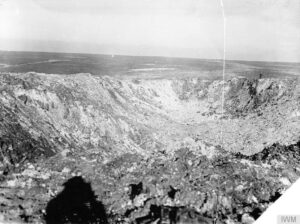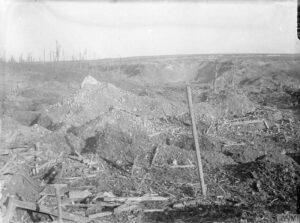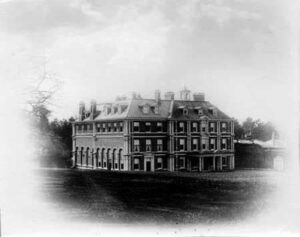•
(Caution: Contains spoilers for Episode: S11E01: Shot at Dawn)
Diesen Beitrag gibt es auch auf Deutsch.
•
The episode begins with a black and white picture. “France, July 1916.” is superimposed. It is 1 July 1916 – the first day of the Battle of the Somme.
We see soldiers marching forward. Landmines explode, people scream. But there is a soldier limping in the opposite direction. He is Private Thomas Hicks. He is fleeing from the obviously life-threatening situation and wants to return to the base of the Royal Midsomer Yeomanry. On the road, he meets a car with three officers, including his friend Lieutenant Douglas Hammond. When Douglas asks in astonishment what he is doing here, Thomas Hicks can only mumble an answer and drags himself along behind him to the battlefield. Douglas Hammond pushes the still mumbling private into the car with light pressure.
A short time later, the court martial found Private Hicks guilty of deserting the battlefield without permission. Lieutenant Douglas Hammond is visibly shocked by the verdict and yet he leads his friend out and to the place where he is to be executed and the firing squad commando is already waiting.
Thomas Hicks is placed against the wall and a sack is pulled over his head. Douglas Hammond gives the firing squad the order to shoot, but they fail to execute Hicks. They miss. Douglas walks up to Thomas Hicks with a serious and horrified expression and pulls the sack off his head. He hesitates only briefly, although his face betrays how disgusted he is with himself at that moment. Douglas Hammond shoots his friend in the head with his pistol. After that, the dutiful lieutenant throws up against the nearest wall.
The Hicks and the Hammonds

We later learn from their gravestones that Thomas Hicks was 21 years old, Douglas Hammond two years older. The latter died at the age of 42 in 1935 of depression after what he has done to his friend.
But that’s not all: The guilt-ridden Douglas Hammond has part of the Hammond estate, the 30 acre land called North Meadow, part of a trust: After three generations, this land is to automatically become the property of the Hicks’.
However, this trust is known only to a few and it does not change the family quarrel between the Hammonds and the Hicks’, which existed before 1916 and continues to the present. The Hammonds think the Hicks’ are failures, the Hicks think the Hammonds are murderers. And both families live in Midsomer Parva.
(More Midsomer Parva history? —> This way, please.)
As Tom Barnaby says so well in this episode, “Feuding’s an Olympic sport round here.”
It was not until 90 years later that Thomas Hicks name was added to the memorial to the fallen at the Battle of the Somme. David Hicks is the grandson of Private Hicks and Mayor of Causton. He asks his father Lionel to unveil the name of his dad on the memorial stone. Lionel Hicks pulls aside the cloth that was stretched in front of his father’s name, visibly moved. Mayor Hicks concludes his speech that a great injustice has now been righted and all blemishes have been removed from the Hicks family.
The Battle of the Somme
The Battle of the Somme – a river in northern France – was to be a great victory for the Allied armies of France and England. It was planned for a long time and was also postponed at short notice to the summer of 1916 because France was still severely weakened by the lost battle at Verdun.
What no one in the Allies knew: their plans were betrayed to Germany several weeks in advance by two politically alienated British soldiers from the north of Ireland. This was revealed by research in German archives commissioned by the BBC.
The battle of position and attrition, which ultimately lasted four and a half months, ended in a draw. But the first day of the Battle of the Somme was England’s heaviest loss ever in a war.
The first battle day at the Somme

Back in Midsomer Parva. A re-enactment is taking place: The Royal Midsomer Yeomanry re-enacts the first day of the Battle of the Somme. Numerous posters advertise the event: “See our boys in the trenches. Celebrating 200 years of the Royal Midsomer Yeomanry WW1 Re-Enactment.”
Tom Barnaby has no desire whatsoever to attend this event and once again stand between the feud between Hicks’ and Hammonds. But “Sir”, his Chief Superintendent, has different plans for him and Ben Jones. And so both men attend the re-enactment, in which Joyce also takes part as a World War 1 nurse in disguise.
Captain Johnny Hammond, Douglas’ grandson, comments on the events of July 1, 1916, from a stand in uniform. Unter den 58,000 British troops, die an der Schlacht teilnahmen, waren auch 88 member der Royal Midsomer Yeomanry.
They re-enact the battle, starting with the explosion of the huge landmines that went off at 5a.m. Johnny Hammond signals Corporal Mickey Ryan by hand signal to activate the detonators. Shortly afterwards, a number of soldiers appear from a trench and fire at an unseen enemy in front of them. More detonator whir at a safe distance from the soldiers. You hear a whistle blow and soldiers yelling and falling to the ground. The soldiers of the Royal Midsomer Yeomanry did not survive. Only Thomas Hicks, who withdrew from the battlefield without authorisation and shortly afterwards had to pay for it with his life.
In reality
Well, that’s not quite in line with reality, because it was only at 7:28 am local time that the preparatory mines were detonated almost simultaneously. So in England it was half past six in the morning, not five o’clock.
“Somme. The whole history of the world cannot contain a more ghastly word.” – Friedrich Steinbrecher. (Source: Lewis, Jon E.: A Brief History of the First World War. Eyewitness Accounts of the War to End All Wars 1914–18. London 2014. P. 154.)
For a week beforehand, the Allies had not only concentrated 1437 guns on a specific section of the front, but had also devised and carried out an elaborate system of undermining underground. These had already been detonated for a week. The Allies had thus transformed their battlefield into a moonscape in advance.
The explosion that signified the start of the Battle of the Somme was enormous. Earth and debris flew up to 1200 metres and still today there is a crater 91 metres in diameter and 21 metres deep.
The British were convinced that the German positions had been destroyed by the immense gunfire. Therefore, the attacking troops were ordered to advance in dense lines of riflemen at marching speed and with heavy entrenching equipment. Only the last section was to be run in order to still have enough strength at the end for the expected close combat. Afterwards, the Allied soldiers were to expand and secure the bombed German trenches.
But… Despite the heavy barrage, barbed wire entanglements and dugouts on the German side had remained intact to allow for an effective defence. After all, they had learned about the strategy in advance and were able to prepare and set up accordingly. Moreover, the specially created lunar landscape was not necessarily the best starting position, and an obstacle to their own supplies.
“It was worse than hell itself”
And so it came to pass as it had to: after the British soldiers ceased firing, the German soldiers left their dugouts, quickly readied their machine guns, and took machine-gun fire on the frontally attacking British troops. Only a few German trenches could be taken. And even these had to be abandoned again after a short time.
It was the heaviest day of losses in British military history. Of the 120,000 soldiers who attacked the German positions on the first day of the Battle of the Somme, 20,000 were killed, 8,000 of them in the first half hour alone. In addition, about 36,000 were wounded and 2,100 were reported missing in action. Individual regiments lost well over half of their data within hours, and entire divisions were considered non-existent.
“It was worse than hell itself. Such a row I have never heard before in my life, and it was terrible to see the men lying in the field of battle. I can tell you anybody who came out of that scrap on that first morning was lucky.” – Lancaster Fusilier Harold Beard (Source: Kendall, Paul: Somme 1916. Success and Failure on the first day of the Battle of the Somme. Barnsley 2015.)
Also because the commanding General Morland ordered new waves of attacks over and over again from his post at a safe distance. It is only too understandable that Thomas Hicks ran from the battlefield and thus deserted. Moreover, the British soldiers were mostly new recruits, the Germans already experienced front-line soldiers.
Playing a prank

At around 22:30 local time, the Germans were able to recapture the formerly British areas, which increased the pressure on the British soldiers even more.
Back to Midsomer Parva. It is the evening after the re-enactment. Henry Hammond and his daughter-in-law Arabella are sitting on the veranda in the dark. She says goodbye shortly after, he remains sitting outside. Henry Hammond is Douglas Hammond’s son and quite an unsympathetic character.
The Hammond estate was filmed in Hall Barn in Beaconsfield, Buckinghamshire. The present manor was built in the Stuart period, but altered and added to in the 19th century.
While Henry Hammond is still sitting outside, Mickey Ryan and three other members of today’s Royal Midsomer Yeomanry have been building up their courage. They break into his mansion, tie up the man, who is confined to a wheelchair, and blindfold him. Then they drive him a certain distance in his wheelchair and reenact Thomas Hick’s execution there – with blanks.
Taking revenge
What they don’t know: Another person knows about their game and waits in the background. He carries a sharp weapon and after the four Yeomanry members have left and Henry – still tied up and blindfolded – is left standing in place, he carries out the execution. To cover up the murder, he manipulates the technology in the wheelchair and makes the dead man drive straight into the milkman’s car.
Pathologist George Bullard soon finds out that it was a murder. Soon afterwards, the murder weapon is found: it is, of all things, the revolver with which Thomas Hicks was executed. Forensics confirms this: the revolver is the service revolver of a military officer and the number shows that it was issued to Douglas Hammond in September 1915.
In the end it clarifies: It was indeed a Hicks, namely Lionel, who wanted to avenge his father over many years and with a lot of patience.
It remains to be seen whether Douglas Hammond and Thomas Hicks were really half-brothers. Both gravestones read “Royal Midsomer Yeomanry / Brothers in Arms / Brothers in Life”, but is this proof enough? Only from Biddy Dixon comes the reference to the relationship. She has thus given her Lionel Hicks a very conclusive justification for the shooting, which he also gives when he is arrested. Douglas Hammond is said to have killed Thomas Hicks only because he did not want a Hicks to become part of the Hammond family.
But the agreement in the trust, the constant search for forgiveness and the early death of Douglas Hammond rather testify that he acted out of a sense of duty and nothing else.
Read more about Midsomer Murders & History
The Chronology of Midsomer County by Year or by Episodes • Deep Dives into Midsomer & History • History of Midsomer Murders Film Locations
I would like to point out that this is an unofficial fan site and I am not connected to Bentley Productions, ITV or the actors.

Literature
- Abbey, Sue: The Hall Barn Estate. In: Beaconsfield History.
- BBC TV: The Somme 1916 – From Both Sides of the Wire. 3. August 2016.
- Edmonds, J. E.: Military Operations France and Belgium 1916. Sir Douglas Haig’s Command to the 1st July. Battle of the Somme. London 1993.
- Kendall, Paul: Somme 1916. Success and Failure on the first day of the Battle of the Somme. Barnsley 2015.
- Lewis, Jon E.: A Brief History of the First World War. Eyewitness Accounts of the War to End All Wars 1914–18. London 2014.
- NN: Parishes: Beaconsfield. In: William Page (Ed.): A History of the County of Buckinghamshire. Volume 3. London 1925. P. 155-165.
- NN: The Opening Day, Battle of the Somme, 1916. In: Government of Canada (14/02/2019).
- Philpott, W.: Bloody Victory. The Sacrifice on the Somme and the Making of the Twentieth Century. London 2009
- Prior R./Wilson, T.: The Somme. New Haven 2005.
First published on MidsomerMurdersHistory.org on 26 December 2023.
Updated on 15 June 2025.


3 thoughts on “Midsomer and the Battle of the Somme”